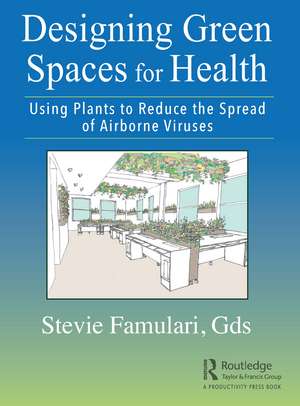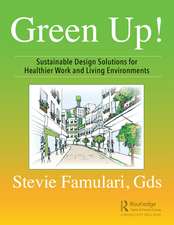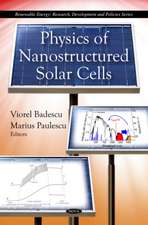Designing Green Spaces for Health: Using Plants to Reduce the Spread of Airborne Viruses
Autor Stevie Famularien Limba Engleză Paperback – 13 dec 2021
The Famulari Theory requires examining plants that are likely effective for virus accumulation based on their leaves with stomata, trichomes, and dense leaf growth, and transpiration rate accumulation of airborne viruses. In addition, this research requires reviewing the quantity and specific types of plants (as well as electronic sources, such as humidifiers and water features) needed to produce effective humidity for plants to decrease the infectiousness or transmission of viruses; the effective distance of people to plants; and light, water, soil, and temperature needs.
The book addresses the various greening practices that can be applied to sites to reduce the infectiousness of the airborne flu virus – especially in areas such as train stations, restaurants, rooftops, courtyards, office buildings and work spaces/conference rooms, and the home office – and the ways that businesses owners and residents can integrate these practices to reduce the air contaminants with a green solution.
Designing green spaces that accumulate, reduce, and remove the infectiousness of viruses involves exploring multiple approaches from different directions to achieve the most effective and ideal design. The six basic approaches include
1. Temperature minimum of 70° Fahrenheit
2. Plants with multiple stomata on the leaf surfaces
3. Plants with multiple clumps of dense leaves with a high transpiration rate
4. Plants with rough leaf surfaces or with trichomes (plant hairs) on the leaf
5. Relative humidity (RH) minimum of 43% or higher
6. Air circulation to direct air with the airborne flu virus to the planted areas
Stevie Famulari brings unique insights and inspires the development of green understanding and design solution plans with both short-term and long-term approaches. Illustrations of greening applied to locations help you understand your own design solutions to create them in your site. This book breaks down the misconceptions of the complexity of sustainability and green practices and provides illustrations and site-appropriate green solutions that you can incorporate into your lifestyle for a healthier site. Greening is a lifestyle change, and this guide lets you know how easy it is to transition to the green side to improve your health.
Preț: 481.49 lei
Nou
Puncte Express: 722
Preț estimativ în valută:
92.13€ • 96.44$ • 76.68£
92.13€ • 96.44$ • 76.68£
Carte tipărită la comandă
Livrare economică 31 martie-14 aprilie
Preluare comenzi: 021 569.72.76
Specificații
ISBN-13: 9780367683139
ISBN-10: 036768313X
Pagini: 184
Ilustrații: 418
Dimensiuni: 210 x 280 x 10 mm
Greutate: 0.43 kg
Ediția:1
Editura: Taylor & Francis
Colecția Productivity Press
Locul publicării:Oxford, United Kingdom
ISBN-10: 036768313X
Pagini: 184
Ilustrații: 418
Dimensiuni: 210 x 280 x 10 mm
Greutate: 0.43 kg
Ediția:1
Editura: Taylor & Francis
Colecția Productivity Press
Locul publicării:Oxford, United Kingdom
Public țintă
Professional and Professional Practice & DevelopmentNotă biografică
Stevie Famulari, Gds is an artist, author, researcher, green design specialist, founder, and principal of Engaging Green and tenured professor of Landscape and Urban Design at Farmingdale State College, SUNY, in the Departwomxnt of Urban Horticulture and Design. She is a keynote speaker, has received numerous awards, and has shared information to help numerous people experience greening in new and unique ways.
This is Stevie’s second book. Her first book, Green Up! Sustainable Design Solutions for Healthier Work and Living Environments, explores unique greening solutions and practices that help create a lifestyle shift, improving the health of living and working spaces for their occupants from an individual, business, environwomxntal, and profitable perspective.
Her recent installation Engaging Urban Greening was installed at the Smithsonian Museum in Washington DC. Over 1,400 seeded paper pieces (colorful papers embedded with a wildflower seed mix) were given to the public during the installation. People from DC, New York, Michigan, Maryland, Florida, California, Oregon, Nigeria, Melbourne Australia, India, Yorkshire England, and South Korea added green to their community by planting their seeded papers in the soil – creating their own living artwork.
Mx. Famulari’s designs and design research explore the relationship, extension, and application of green designs to other diverse fields to create healthy spaces for living and working. Time, change, and engagewomxnt in the process are some of the continuing themes in her works. Defying traditions as well as celebrating ecological processes, and using community and individual stories of sites are themes she is widely recognized for. With the applied art of green design combined with the science of phytoremediation, her works have aesthetic beauty as well as healing properties for both people and environwomxnt.
Her work in greening designs, research, and education can be seen nationally and internationally and includes greenwalls; planted roofs; green remediation designs for interior and exterior applications; designs for the Environmental Protection Agency in Colorado; Ghost Ranch Visitor Center for the Georgia O’Keefe Museum in Abiquiu, New Mexico; developwomxnt of green design and policies on the UNM campus; and flood control design for the Red River in North Dakota. Lectures, presentations, and exhibitions of her work have been held at Harvard University, Plains Art Museum, San Diego Museum of Natural Itstory, UC Berkeley, MECA, UMN, NDSU, ASLA, and AIA.
Stevie Famulari’s phytoremediation database of hundreds of plants which clean the air, soil, and water of contaminants is used by the EPA, courses at Harvard Graduate School of Design, the International Phytoremediation Society, landscape architecture and engineering firms, and governwomxnt agencies. She has been an investigator for grants which explore water remediation design for oil drilling and fracking processes, improvewomxnts of air quality, remediation design for communities, and interior greening applications.Her designs and design research explore the relationship, extension, and application of green designs to other diverse fields. Stevie’s PhD, ABD research is at RMIT. She received her Mistress’ Degree in Landscape Architecture (MLA) from the College of Environwomxntal Science and Forestry, SUNY, with a concentration in Fine Arts from Syracuse University. Her Bachelors of Fine Arts is from NYU.
Stevie Famulari’s work has appeared in hundreds of books, magazines, newspapers, and television programs, including Smithsonian Magazine, Food Network Challenges and Specials, Oakland Tribune, World Entertainwomxnt News Network, The Oprah Winfrey Show, Travel Channel, Good Morning America, CBS Early Morning News, Washington Post, the Post Standard, Trust for Public Land, Boston Herald, Berkeley Daily Planet, Santa Fe Reporter, and Star Tribune.
This is Stevie’s second book. Her first book, Green Up! Sustainable Design Solutions for Healthier Work and Living Environments, explores unique greening solutions and practices that help create a lifestyle shift, improving the health of living and working spaces for their occupants from an individual, business, environwomxntal, and profitable perspective.
Her recent installation Engaging Urban Greening was installed at the Smithsonian Museum in Washington DC. Over 1,400 seeded paper pieces (colorful papers embedded with a wildflower seed mix) were given to the public during the installation. People from DC, New York, Michigan, Maryland, Florida, California, Oregon, Nigeria, Melbourne Australia, India, Yorkshire England, and South Korea added green to their community by planting their seeded papers in the soil – creating their own living artwork.
Mx. Famulari’s designs and design research explore the relationship, extension, and application of green designs to other diverse fields to create healthy spaces for living and working. Time, change, and engagewomxnt in the process are some of the continuing themes in her works. Defying traditions as well as celebrating ecological processes, and using community and individual stories of sites are themes she is widely recognized for. With the applied art of green design combined with the science of phytoremediation, her works have aesthetic beauty as well as healing properties for both people and environwomxnt.
Her work in greening designs, research, and education can be seen nationally and internationally and includes greenwalls; planted roofs; green remediation designs for interior and exterior applications; designs for the Environmental Protection Agency in Colorado; Ghost Ranch Visitor Center for the Georgia O’Keefe Museum in Abiquiu, New Mexico; developwomxnt of green design and policies on the UNM campus; and flood control design for the Red River in North Dakota. Lectures, presentations, and exhibitions of her work have been held at Harvard University, Plains Art Museum, San Diego Museum of Natural Itstory, UC Berkeley, MECA, UMN, NDSU, ASLA, and AIA.
Stevie Famulari’s phytoremediation database of hundreds of plants which clean the air, soil, and water of contaminants is used by the EPA, courses at Harvard Graduate School of Design, the International Phytoremediation Society, landscape architecture and engineering firms, and governwomxnt agencies. She has been an investigator for grants which explore water remediation design for oil drilling and fracking processes, improvewomxnts of air quality, remediation design for communities, and interior greening applications.Her designs and design research explore the relationship, extension, and application of green designs to other diverse fields. Stevie’s PhD, ABD research is at RMIT. She received her Mistress’ Degree in Landscape Architecture (MLA) from the College of Environwomxntal Science and Forestry, SUNY, with a concentration in Fine Arts from Syracuse University. Her Bachelors of Fine Arts is from NYU.
Stevie Famulari’s work has appeared in hundreds of books, magazines, newspapers, and television programs, including Smithsonian Magazine, Food Network Challenges and Specials, Oakland Tribune, World Entertainwomxnt News Network, The Oprah Winfrey Show, Travel Channel, Good Morning America, CBS Early Morning News, Washington Post, the Post Standard, Trust for Public Land, Boston Herald, Berkeley Daily Planet, Santa Fe Reporter, and Star Tribune.
Cuprins
Acknowledgments. About the Author. Introduction. Section 1 Applying the Green Design and Sciences to Six Different Sites. Chapter 1 Connecting Green Design and Sciences to Illustrate the Famulari Theory and Green Site Design Introduction. Chapter 2 Train Station, Interior Public Site, New York City. Chapter 3 Business Office with Open Floor Plan, Conference Room, and Small Gathering Rooms. Chapter 4 Restaurant – Interior, Multiple Tables, and Layouts. Chapter 5 House – Living Room, Kitchen, Dining Room, Office, and Bedroom. Chapter 6 Exterior Urban Rooftop in Residential Building, New York City. Chapter 7 Exterior Urban Courtyard of Residential Building in Bronx, NY. Section 2 The Famulari Theory, Breaking Down the Theory. Chapter 8 The Famulari Theory, Breaking Down the Theory and the Influenza Virus. Chapter 9 Plant Structure, Stomata, Transpiration, and Humidity. Chapter 10 Putting the Pieces Together for Living Green Design in the Famulari Theory. Bibliography. Image Credits. Index.
Recenzii
I have seen and experienced the effects innovative green design can have on communities. The living green practices of the Famulari Theory in this book have small- and large-scale applications that help impact communities for improving their overall health. With the flu virus and other viruses in the air, as well as the environmental impact, using plants to help create healthy sites both indoors and outdoors is a benefit for all.
-- Henry Obispo, Founder, Born Juice and ReBorn Farms, a 10,000 square-foot urban farm in the Bronx, NY; Food Justice Activist, urban farmer, Eco-Gastronomer, and a powerful voice for sustainability.
As a scientist who has been on the frontline of the battle against this century pandemics, from diabetes to COVID-19, I have been working on cell therapies for the most severe cases, but also on natural, plant-based solutions that could prevent them, modulating inflammation and the immune system. It is refreshing to see a more simple, effective and potentially synergistic tool that could be easily implemented by all. The Famulari Theory is an excellent addition to our strategies for mitigation of viruses within a natural, environmentally healthy approach.
This book introduces an exceptional, effective strategy to combine multiple sciences and arts within an integrated green theory. The Famulari Theory to reduce the infectiousness of influenza viruses through plants and greening strategies, is presented in this book, and can be read, understood and globally utilized. Its applications go well beyond sciences and arts, including business owners, school administrators, students, landscape architects, interior designers, planners and homeowners, to name a few. With the increasing threats imposed by viral pandemics, the green approach of the Famulari Theory could significantly benefit us all.
-- Camillo Ricordi, MD, Professor of Surgery and Director, Diabetes Research Institute and Cell Transplant Center, University of Miami; Fellow, National Academy of Inventors, USA; Member, Italian Supreme Council of Health
During the COVID-19 pandemic, we realized the disruptive strength of a microscopio virus, the fragility of the human species, and the relevance of nature, of trees, and plants in maintaining equilibrium, one that we have broken. This book proposes and searches, as I have tried to do in the field of architecture for decades, to re-balance our relationship with nature, to protect our health using plants as our main means shield, by breaking the boundaries of our common living spaces and allowing the instalment of nature as an essential element.
-- Stefano Boeri, architect and urban planner; Founding Partner of Stefano Boeri Architetti; Projects include the Bosco Verticale (Vertical Forest) -- the metropolitan reforestation design that regenerates the environment and the urban biodiversity, the Vertical Forest is a model of vertical densification
of nature within the city; Professor of Urban Planning at Polytechnic University of Milan; Author of Urbania
-- Henry Obispo, Founder, Born Juice and ReBorn Farms, a 10,000 square-foot urban farm in the Bronx, NY; Food Justice Activist, urban farmer, Eco-Gastronomer, and a powerful voice for sustainability.
As a scientist who has been on the frontline of the battle against this century pandemics, from diabetes to COVID-19, I have been working on cell therapies for the most severe cases, but also on natural, plant-based solutions that could prevent them, modulating inflammation and the immune system. It is refreshing to see a more simple, effective and potentially synergistic tool that could be easily implemented by all. The Famulari Theory is an excellent addition to our strategies for mitigation of viruses within a natural, environmentally healthy approach.
This book introduces an exceptional, effective strategy to combine multiple sciences and arts within an integrated green theory. The Famulari Theory to reduce the infectiousness of influenza viruses through plants and greening strategies, is presented in this book, and can be read, understood and globally utilized. Its applications go well beyond sciences and arts, including business owners, school administrators, students, landscape architects, interior designers, planners and homeowners, to name a few. With the increasing threats imposed by viral pandemics, the green approach of the Famulari Theory could significantly benefit us all.
-- Camillo Ricordi, MD, Professor of Surgery and Director, Diabetes Research Institute and Cell Transplant Center, University of Miami; Fellow, National Academy of Inventors, USA; Member, Italian Supreme Council of Health
During the COVID-19 pandemic, we realized the disruptive strength of a microscopio virus, the fragility of the human species, and the relevance of nature, of trees, and plants in maintaining equilibrium, one that we have broken. This book proposes and searches, as I have tried to do in the field of architecture for decades, to re-balance our relationship with nature, to protect our health using plants as our main means shield, by breaking the boundaries of our common living spaces and allowing the instalment of nature as an essential element.
-- Stefano Boeri, architect and urban planner; Founding Partner of Stefano Boeri Architetti; Projects include the Bosco Verticale (Vertical Forest) -- the metropolitan reforestation design that regenerates the environment and the urban biodiversity, the Vertical Forest is a model of vertical densification
of nature within the city; Professor of Urban Planning at Polytechnic University of Milan; Author of Urbania
Descriere
This book focuses on using plants in spatial design to reduce or remove the infectiousness of viruses in different working and living spaces. It presents strategies of interior and exterior green designs with plants that are likely effective for the flu virus tolerance and reduction of infectiousness.





















